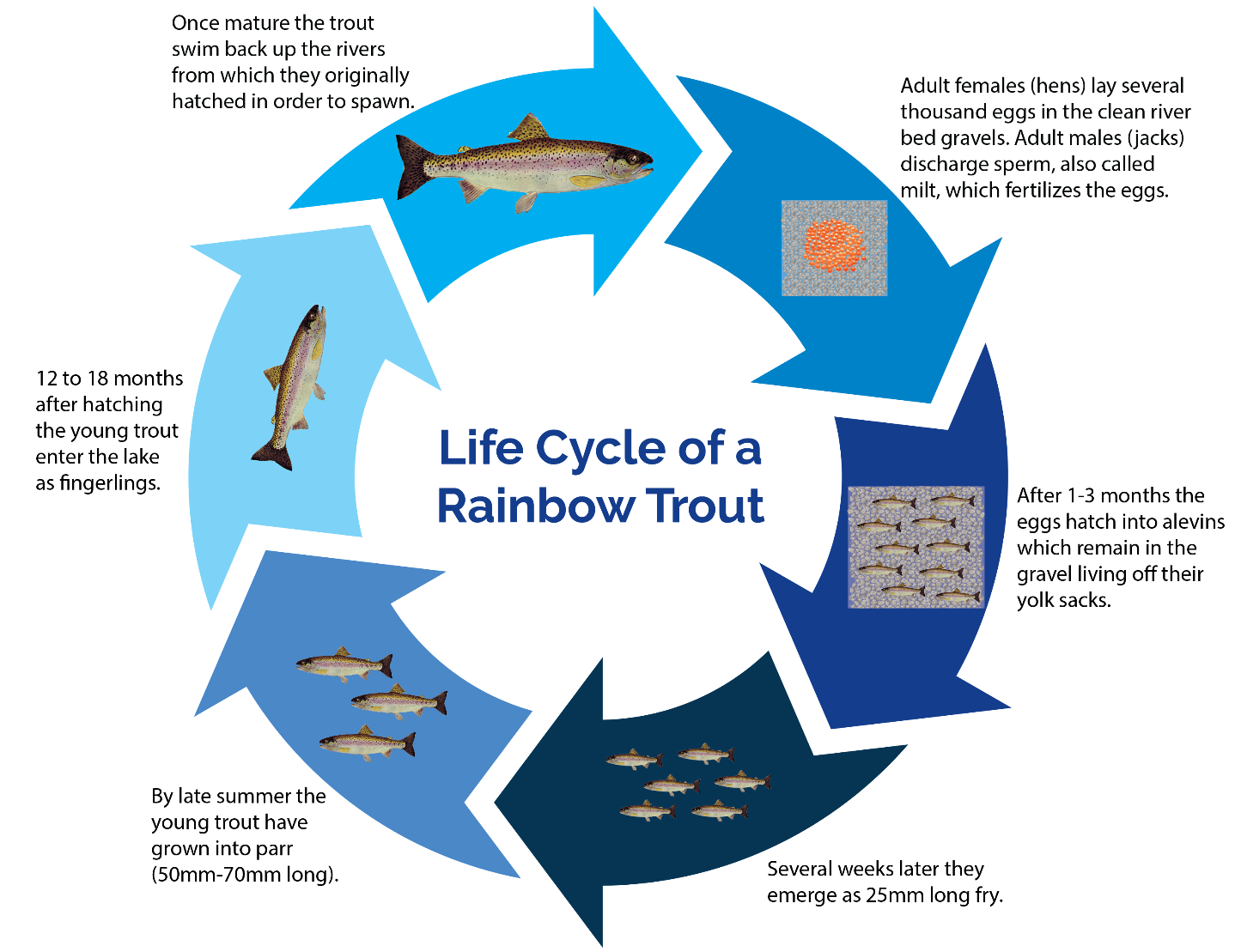Kids' Fish Art Contest classroom activities
Seven classroom lessons for use with the Kids' Fish Art Contest, an annual art and essay contest for Ontario students.
Welcome to the Kids' Fish Art Contest teacher resources for fall 2019. The materials you will find here provide an active, involving way to create a learning unit around the contest, from an introduction to the value of fish to the final creation of contest artwork and the related essay. The activities form a stepwise process from research to sketches to composition studies to final art. Artwork must be submitted by December 6, 2019. Download the entry form that must accompany the artwork.
All the activities are appropriate for all ages. One actively involves students in a major management issue related to both fish, while another focuses on a key visual adaptation to the fish’s environment. The activity sequence is described briefly below.
Activity 1 - Webs and stacks
Students use word webs to illustrate the value of fish to the environment and to people. They visualize the economic worth of sport fish using a stack of loonies and must calculate how high that stack would be. Along the way, they learn about the life and times of the lake trout during Ontario's recent past.
Activity 2 - Know Your fish!
Students research their fish, using the Internet and the point-form resource sheets included in the activity. By the end, students gather most of the information needed for their essay and produce a simple but identifiable line drawing of their fish.
Activity 3 - Fish and habitat balance mobiles
This activity focuses on habitat. Students create mobiles that demonstrate the balance of habitat components for each fish, and include the fish they created in Activity 2. They can now complete the required essay.
Activity 4 - Globe-trotting Trout
Students will be familiar with the native range of rainbow trout and the history of introduction, and be able to identify advantages and disadvantages of stocking Rainbow Trout outside of its native range.
Activity 5 - Perch predicament
Students will know the importance of food, water and shelter to yellow perch, as well as some types of food and shelter that perch require, and are adapted to.
Activity 6 - Sketch studies
Students learn field-sketching techniques and apply them to the key characteristics of their fish and its habitat, as they go on a virtual field trip that brings them up close and personal with the fish of their choice.
Activity 7 - Young angler's licence artwork
Students integrate art and design principles into a series of composition studies, and then into their final contest artwork.
Activity 1 - Webs and stacks
- Purpose: To explore the environmental and economic value of fish for Ontario.
- Outcomes: Students will be able to:
- describe some of the environmental and economic relationships of Ontario fish
- describe some of the impacts if those relationships are severed, using lake trout as an example
- visualize the economic worth of sport fish to Ontario
- Subject:
- science
- biology (ecology)
- mathematics
- Group size: Class
- Site: Classroom
- Time: 1 hour plus homework
- Supplies: Newsprint if desired
References:
The distance between any two relatively large cities
A quick look
Students will use word webs and a reading assignment to explore the environmental and economic value of fish to the province of Ontario.
Ready, set, go!
Part A
First, ask students for the names of different kinds of animals, and list them on the board or newsprint in the order that they mention them. Chances are it will be a while before fish or any particular kind of fish comes up. Ask them why that might be, since fish:
- at 400 million years old, are the world’s oldest (and, some might argue, most successful) vertebrates
- at upwards of 25,000 species worldwide, represent more than half of all animals with backbones; many more, especially from deep sea areas, may be undiscovered
- with over 160 species in Ontario, almost double the number of mammals here.
If fish do not come up near the top, indicate that it might be because fish are largely an invisible resource, hidden beneath the surface, largely out of sight and out of mind. And that now they are going to "uncover" some things about fish.
Now, write the word "fish" in the middle of the blackboard or a large piece of newsprint. Ask students to brainstorm all the words they can think of that relate to it. Encourage them to explain if the linkage is not obvious. Begin to create a web out of the words provided. Continue until you've either run out of words or run out of space.
Next, circle related words in the same colour, e.g., descriptive terms (slimy, scaly, slippery, streamlined) in red, ecological/relational terms in green (fish food, water, insects, habitat, energy) and human-related terms in blue (fishing, eating fish, tackle, lures, bait, boats).
Part B
Indicate that they are going to focus on the ecological value of fish by looking at one fish: the lake trout. Read A Lake Trout Story together with the class, or assign as homework, depending on the class reading level. As they read, have them list or draw all the ecosystem links that contain lake trout, and all the direct or indirect impacts resulting from the loss of lake trout.
Once the assignment is complete, summarize their findings on the board in a new web with lake trout in the middle. Highlight the effects of breaking some of those strands.
Point out that, while lake trout is an extreme example due to its position as a keystone species in a major lake system, the loss of any fish will have similar, if less obvious, "ripple effects." The last part of the article is a cautionary tale: when we break something in nature, it is sometimes harder than we think to put it back together again!
Part C
Take another look at the human-related words. Most should relate to either fishing or eating fish. Indicate that while fish are used for oils, dietary supplements, leather, fertilizers and animal feed, fishing for food and/or sport is a primary activity, one that here in Ontario contributes greatly to the provincial economy. In fact, the sport fishery alone, is worth over 2.5 billion dollars through sales of supplies, equipment, boats, vehicles and lodging directly or indirectly related to fishing.
Now, 2.5 billion of anything is hard to visualize. Challenge your students to imagine a stack of 2.5 billion loonies. How tall would it be, assuming each loonie to be 2 millimetres thick? (5.0 billion millimetres) How many kilometres is that? (5000) How far is that from the nearest major city? Take some guesses, e.g., London to Saskatoon, and find out how far that might be on a map or globe. Use the distance website under References to confirm and refine your estimates. How long would it take to drive there, averaging 80 kilometres/hour? (62.5 hours) How many years of spending would it take for your loonie stack to circle the earth? (40,000 kilometres circumference/5000 kilometres/year = 8 years).
Other ideas
Challenge your students to come with other ways to creatively visualize $2.5 billion.
A Lake Trout Story
Lake trout were once the kings and queens of the Great Lakes. They were like a spider at the middle of a web: remove it, and the whole system may unravel. And it did.
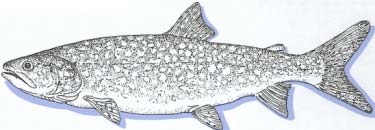
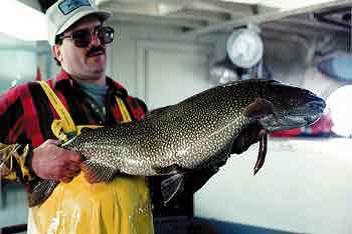
To begin at the beginning, lake trout live and grow best in very cold water. When glaciers were near, lake trout were probably found in most Ontario lakes. During warmer periods, such as the one we're in now, lake trout generally retreat to the colder waters of deepwater lakes.
As a result, lake trout are found in less than 1 % of Ontario’s quarter- to half-million lakes (about 4000 or so). But that 1 % includes the Great Lakes.
When Europeans first came here, lake trout ruled the Great Lakes, dining on other fish, smaller lake trout and a range of aquatic insects and shrimp. Lake trout:
- are large (can easily top 23 kg, the average weight for a 7-year-old boy; the angling record, from Lake Superior, is over 28.6 kg
- can live for a long time (commonly 20-25 years, up to 60)
- grow slowly, and mature late for a fish (6-7 years)
At first, there were at least 15-20 different kinds of lake trout. These fish were different in where they were found, when they spawned (reproduced), and in how they looked. They were named blacks, redfins, yellowfins, paper bellies, fats, humpers and sand trout. Today, most of these fish are gone. Scientists now recognize two types: siscowet or deepwater lake trout found deeper than 90 metres, and leans, or shallow water (less than 90 metres) lake trout.
People living near the Great Lakes have always fished for lake trout. Small amounts caught by scattered tribes grew to a yearly catch of 7.7 million kilograms in the Great Lakes. Lake Superior commercial fishermen generally caught about 2.3 million kilograms each year, and Lake Huron somewhat more, during the first half of the 20th Century. Then the bottom fell out and catches plunged to 10 % of the old amounts in "lucky" Lake Superior and basically nothing in the other Great Lakes. Why? There are at least three reasons:
-
Fishing pressure
While the total catch stayed about the same, more people were catching fish with better and better equipment. lake trout numbers were falling. The very adaptations that had proved so successful – late maturation, slow growth and long life, meant that populations could not quickly bounce back.
-
Sea Lamprey predation
These new, blood-sucking parasites passed through the Welland Canal (going around Niagara Falls) and invaded the upper Great Lakes, peaking between 1950 and 1960. At the same time, lake trout numbers dropped, and most of the trout left had lamprey scars. Lamprey control methods were developed before populations were wiped out in Lake Superior, but Huron was not so lucky - only two isolated populations of native Lake Trout survived in Ontario waters.
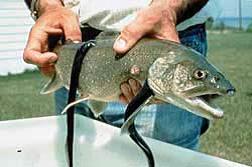
-
Habitat problems
Over this same period, the actions of people hurt the Great Lakes. Digging out ship channels and canals spread mud and silt over the bottom. Sewage and fertilizers made the wrong kind of plants and animals grow, and toxic pollution poisoned the lake trout, in particular the "lean" stocks closer to shore.
By the 1960s, the native fish community was in tatters. Lake trout, lake sturgeon and lake herring populations, as well as some other deepwater fish, had collapsed. Heavy recreational and commercial fishing and habitat losses had reduced or eliminated stocks of many shallow-water species. With no fish left to catch, many small communities on the lake coasts disappeared. Without its top predators the rest of the fish community began to unravel. Several chubs may have become extinct. With nothing to eat them, smelt and alewife populations would explode and then die off from low temperatures or lack of food, leaving piles of dead fish on the shore of some Great Lakes.
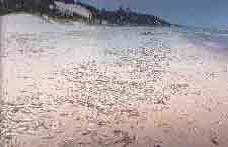
Those fish piles were also a wake-up call, and people and governments responded. Lamprey were brought under reasonable control. Commercial fishing for lake trout was severely limited or closed. Development issues were, and continue to be, addressed. A series of water quality agreements greatly reduced pollution. The waters began to clear. Pacific salmon, brought in to control rainbow smelt and alewife, did just that, and provided a thriving sport fishery to boot.
Once the recovery of lakes began, thoughts returned to the former king of the lakes. Now, said fisheries managers, is the time to bring back the lake trout.
More than 180 million fish have been stocked with mixed results. Superior, with fewer problems than any other lake, responded the best. Stocks native to the lake began to reproduce, and increase. Today, wild trout in many parts of the lake are at pre-crash levels. Most of those populations can once again thrive without help. Only in the eastern part of the lake are numbers below normal, and some fish are still stocked there.
In Lake Huron, lake trout have been increasing in the main part of the lake since 1998, because of sea lamprey control efforts and new catch limits. In addition, invasive alewife numbers are down and native lake cisco numbers are up in some locations, and they are better food for lakers. Chinook salmon compete with lake trout for food, and their numbers have also gone down. As a result, 40 % of a growing lake trout population sampled by NDMNRF in 2010 were wild fish, not stocked.
In Georgian Bay, wild stocks are increasing near Parry Sound, and stocking stopped in that area in 1997. However, lake trout are declining in other parts of Georgian Bay in spite of stocking and other efforts to increase the population. These trout must spawn along nearshore, rock rubble banks, and these areas are sensitive to local impacts. Additional efforts to curb these impacts may be required before wild reproduction succeeds.
In Lake Ontario, lake trout are not reproducing enough to reduce significant levels of stocking.
So while there has been some success in lake trout rehabilitation, Dave Gonder, an NDMNRF biologist states, "It’s kind of a balancing act right now. We don't really know what the future holds." There may be many reasons for this, and they may affect one another:
- We may still not know enough to properly address a challenge as complex as bringing back lake trout.
- All those forms of lake trout had evolved for a reason: the ability to reproduce well in each specific area. But many of those forms are gone. It will take time to find and test forms which may be reasonable replacements.
- People want to fish now. In trying to meet these needs, we may not be leaving lake trout alone long enough to build up the number of large spawners needed to increase populations.
- An unknown number of fish are being illegally netted, adding to the fishing pressure (an estimated 5 times the legal catch in some regions).
- Lake trout ruled in fairly simple biological systems with no direct competitors. They are being reintroduced into lakes now teeming with other large, exotic predators: Chinook and Coho salmon, brown and rainbow trout. While lakers do not directly compete with these fish for spawning habitat, they all have to eat the same food - food that is very different than when lake trout was the boss.
- A lot of people prefer to fish for the introduced sport fish, and there is pressure to stock more of those than lake trout.
- Lake quality may not be good enough yet for healthy populations of lake trout.
- The lakes continue to change, in part due to invasion by zebra and quagga mussels, which have decreased the quality of historic laker spawning reefs, and reduced the amount of plankton that can be eaten by young lake trout. Another invader, the round goby, eats lake trout eggs and fry.
There is, however, hope for the Great Lakes lake trout. We are getting better at picking successful types, or strains, of fish. Younger fish are being released on historic, mid-lake, rock rubble spawning shoals in the hope that they will "imprint" on them and return to spawn. Particular areas are being made into refuges, safe from all fishing. Researchers are looking into the laker’s critical first year of life, and why so many die then. The food supply seems to be changing back into the types of fish lake trout like best.
The final questions may be: Why lake trout? Are they really that important? Do we owe them a new chance because of our actions? Is it enough that they may be the only large predator that may be able to hold its own without our help? Is it even sensible to "restore" a species to its original habitat if neither the fish nor the habitat is "original"? The answers may determine whether the social and political will is there to complete the task.
Activity 2 - Know your fish!
- Purpose: To learn enough about one Ontario fish to produce an identifiable line drawing of it and understand something of its life history.
- Outcomes: Students will be able to:
- draw one of two Ontario fish, rainbow trout or yellow perch, including key characteristics which identify that fish
- describe the habitat and some of the behaviours of that fish
- Subject:
- science
- biology (ecology)
- visual arts
- language (reading)
- Group size: Class
- Site: Classroom
- Time: 45 minutes plus research time
- Supplies:
- Card stock
- drawing tools
- scissors
- Resource Sheets (if required)
- Before the activity: Copy resource sheets if required
References:
A quick look
Students research their fish prior to producing a line-drawing cutout to be used in Activity 3.
Ready, set, go!
Introduce the Kids' Fish Art Contest to the students, using the information from the flyer or web page. Indicate that the winner of this contest – a fish painted or drawn by an elementary or secondary student will be used on the 2020 Young Angler’s Licence, a fun, free, promotional licence that reminds kids about their responsibilities when fishing. Thousands will be distributed across the province.
One key to a good wildlife drawing is knowing the subject matter well; not only how it looks, but how it acts and where it lives. This information is also required for the essay that must accompany each image. Point out that students will now "research" their fish using their own resources, the web resources listed on Resource 3, or the fact sheets on Resources 1 and 2. You can decide what level of research you want your students to pursue. Students may choose their fish first, or choose their fish after doing some of the research. The essay must match the fish that they draw.
Once the research is done, ask the students to do an outline drawing of their fish on card stock that is 7.5 – 10 cm. long. The drawing should show the key features that distinguish and identify their fish. Colour is optional. Once the drawings are done, have the students cut out their fish, and make sure that features are drawn on both sides. Indicate that their fish will be used in the next activity.
Examples of rainbow trout and yellow perch outline drawings can be found here and here.
Resource Sheet 1 – Rainbow Trout
Scientific name: Oncorhynchus mykiss
Onkos – means hook, and rynchos means nose in Greek.
mykiss -- derives from the local Kamchatkan name 'mykizha'
Rainbow Trout are beautiful fish belonging to the salmon family. Although the same species, there are two life history patterns and appearances. Inland lake and stream rainbow trout are more colourful and generally smaller, whereas Great Lake and tributary populations are generally larger and silvery, and are referred to as 'steelhead'. The term 'steelhead' is usually restricted to large, sea-run fish; however, this was the stock introduced to the Great Lakes, which have retained the life history pattern of using the Great Lakes as they originally did the sea. The pink to red lateral band can be distinguished on inland populations year round, but only during breeding in Great Lakes populations. Rainbow trout (including steelhead) are non-native to Ontario waters, but have been widely introduced from the west as a popular sport fish. Rainbow trout are also the most commonly farmed fish in Ontario.
Description:
- colour and size variable with habitat and breeding state
- snout rounded, except in breeding males when it is extended and the lower jaw is turned up
- elongate, compressed body
- many small black spots on body
- tail slightly forked and covered in black spots in radiating rows
- long, stocky caudal peduncle

Rainbow Trout (Inland populations)
- Inland rainbow trout are darker, more colourful, and generally smaller.
- Inland rainbow trout have a distinctive pink to red band along their lateral line.
Steelhead (Great Lakes populations)
- Steelhead, which migrate into Great Lake tributaries to spawn, are lighter, more silvery, and generally larger.
- Steelhead lose their pink to red lateral band after breeding.
Similar to:
- inland rainbow trout are similar to brook trout, brown trout, juvenile Atlantic salmon
- Great Lakes steelhead are similar to chinook salmon, coho salmon, pink salmon and Atlantic salmon
Key identifying features:
- pink to red lateral stripe (only during spawning for steelhead)
- many small black spots on body. No red spots
- black spots all over tail in radiating rows
- long, stocky caudal peduncle
Size:
- inland rainbow trout: average length in Ontario: 15 - 40 cm (6 – 16”)
- Great Lakes steelhead: average length in Ontario: 35 – 60 kg (14 – 24”)
- Ontario record: weight – 18.45 kg (40.68 lb.), length – 99.39 cm (39.13”), McGregor Bay 2005
Distribution and habitat:
- in North America, native to the rivers and lakes west of the Rocky Mountains from northern Mexico to Alaska, and probably the Peace and Athabasca River drainages east of the Rockies. In Eurasia, native to the Kamchatkan Peninsula, as far east as the Commander Islands to as far south as the mouth of the Amur River of mainland Asia. Has been introduced throughout the world
- in Ontario found in suitable streams and lakes south of a line from Kenora to Kesagami Lake
- Great Lakes steelhead are found in all the Great Lakes and many tributaries, as well as in some inland lakes
- prefer cooler (11.3ºC), oxygenated, swift and somewhat turbulent water. Can tolerate, but avoid, warmer temperatures (up to 24ºC). Gravel substrate to spawn

Rainbow Trout North American range map.
Modified from Scott and Crossman. 1985.
Food:
- plankton
- insect larvae
- insects
- leeches
- ails
- clams
- other mollusks
- larger crustaceans
- fish eggs
- minnows
- other small fish
Predators:
- diving birds
- ospreys
- great blue herons
- mammals
- larger fish
- numerous parasites, including:
- sea lamprey
- Myxobolus cerebralis, a myxosporean parasite which causes whirling disease
- susceptible to enteric redmouth disease caused by the bacteria Yersinia ruckeri
- humans
Reproduction:
- inland rainbow trout spawn in streams from March to May
- Great Lakes steelhead enter spawning streams from late October to early May and spawn from late December to late April
- spawning temperature is usually between 10.0-15.5ºC (50-60ºF) typically, a bed of fine gravel in a riffle above a pool is chosen. The female digs a redd (nest) by turning on her side and beating her tail to form a pit that is longer and deeper than her body
- males court a female by sliding along and crossing over her body, rubbing his snout against her caudal peduncle, and body pressing and vibrating
- when ready to spawn, the female rests in the redd, the dominant male quickly presses parallel to her, both fish vibrate, the female releases the eggs (about 800-1000 small, pink-orange in colour), and the male releases the milt containing sperm - all in a few seconds
- the female immediately digs on the upstream edge of the redd so that displaced gravel covers the eggs
- no parental care is given
- females dig and spawn in several redds with the same or different males
- depending on water temperature, eggs hatch approximately 4-7 weeks later
- Alevins take an additional 3-7 weeks to absorb the yolk
- Steelhead fry may return to the Great Lakes or spend as much as 1-3 years in nursery streams
- sexually maturity can be reached as early as 1 year by males to as late as 6 years for females. Generally maturity is reached within 3-5 years, with the males maturing a year before females
- if conditions are favourable, mature fish will spawn every year
- life span for inland stream and small lake fish can be as low as 3 or 4 years, and up to 11 years for larger inland lake fish. Life span for Great Lakes Steelhead is about 6 to 8 years
Management tips
- protect habitat and habitat quality
- protect and rehabilitate riparian zones to provide stream cover (shade), and to prevent erosion, pollutant run-off and increased water temperatures
- use “best management practices” with respect to urban and rural development, agriculture, forestry, and other industry
- ensure that septic tanks are not faulty
- reduce hard surfaces such as concrete near water bodies that results in higher water run-off temperatures
- reduce greenhouse gas emissions driving climate change that contributes to increased water temperatures
- respect fishing regulations
- collect long-term data to help monitor the health of aquatic communities, and identify and address problems
- dams, confinement of streams to concrete channels, land development, and changes to water courses should be subject to careful consideration and environmental impact assessments
- aquaculture practices should be regulated to: prevent escapees which may interbreed with wild individuals and lessen genetic diversity and viability, limit nutrient enrichment, and the spread of parasitic diseases
Trace the trip
A Steelhead tagged and introduced to a river in Michigan was taken 8 months later in the Bay Quinte, Lake Ontario. It had travelled about 966 km (600 miles), and survived a descent of Niagara Falls (unless it negotiated the Welland Ship Canal).
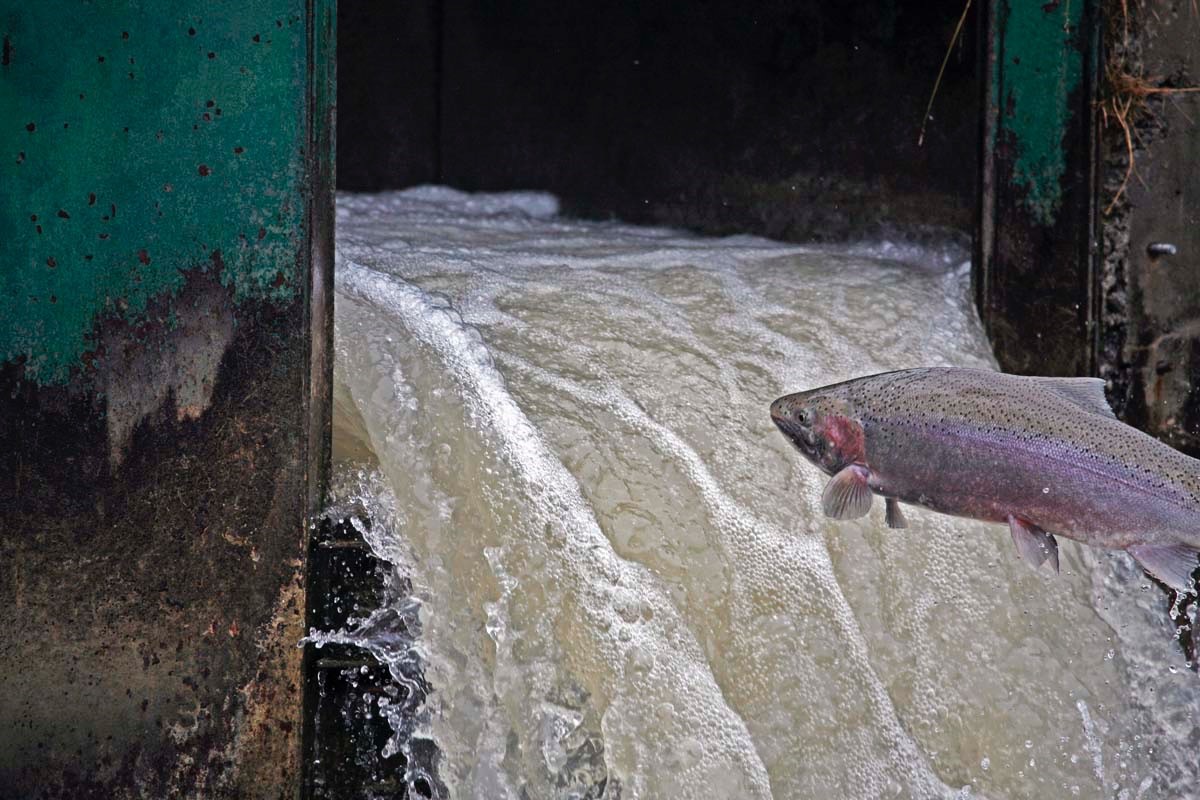
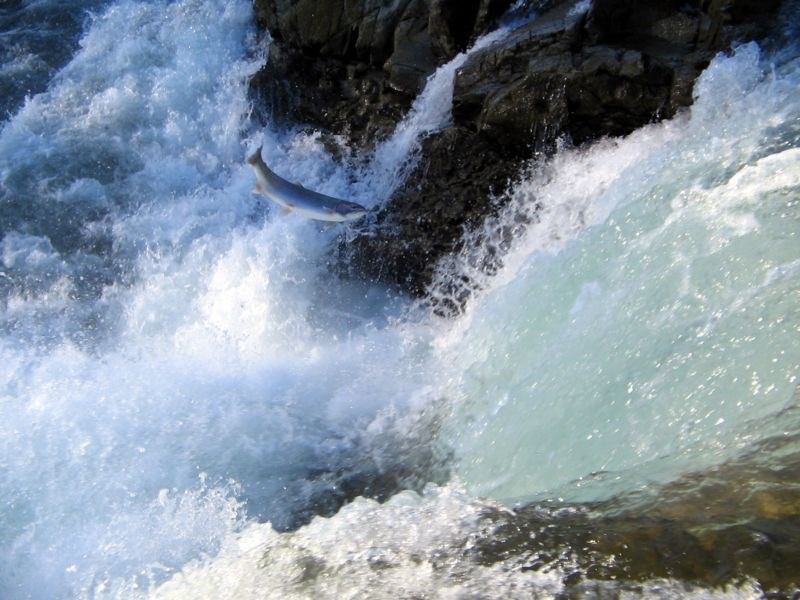
Resource Sheet 2 - Yellow Perch

Scientific name: Perca flavescens
Perca means spotted or dusky, and flavescens means yellowish.
Yellow perch are related to big brothers walleye and sauger, and are widely distributed across North America. Along with other panfish like bluegill and pumpkinseed, they often form an introduction to the sport of angling for many young people, and remain a popular catch for many older anglers. As one of the smaller sportfish, they also provide an important trophic link between smaller baitfish and the larger trophy species. They also form an important commercial fishery, particularly in Lake Erie.
Description:
- light yellow body
- 6 to 8 dark, vertical bands on sides
- 2 separate dorsal fins
- large mouth extending to below the middle of the eye
Similar to:
- Walleye
- Sauger
- White perch
Key identifying features:
- vertical bands
- forked tail
- yellow colour
- first dorsal fin has 12-14 spines
- no canine teeth (distinguishes it from young walleye)
Size:
- average length: 15-35 cm (6-12 inches)
- average weight: 0.35-1 kg (0.75-2.2 lb.)
- Ontario record:
- weight – 1.12 kg (2.46 lb.)
- length – 39.4 cm (15.51 inches)
- females grow faster and larger than males
Distribution and habitat:
- broadly distributed in Ontario and Canada. Introduced within and outside of native range. Fresh waters from Atlantic to Pacific coast, and from Hudson Bay to Great Lakes and its tributaries. Introduced to southern and eastern British Columbia, and margins of northern and southern ranges
- clear lakes, ponds and sluggish streams
- prefer areas of open water with moderate vegetation
- usually found near shallow bottoms in bright light; overwinter in deeper water, and may seek deeper water if the shallows exceed 21ºC (71ºF)
Food:
- feed in schools
- young of the year: zooplankton
- juvenile fish: benthic macroinvertebrates
- adults: smaller fish
Predators:
- Lake Trout, Northern Pike, Muskellunge, Walleye, Cormorants, Loons and diving ducks
- small walleye, alewife, white bass and white perch eat larvae and fry
- numerous parasites
- humans
Reproduction:
- Spawn in April and May, usually at night
- Move into shallow lake waters (typically 1.5-3 m) or up large rivers
- Eggs and sperm are deposited more or less randomly over spawning grounds
- No parental care
- Eggs hatch in 8 to 21 days
- Perch mature at 2-4 years of age, with males usually maturing a year before females
Management tips:
- protect habitat and habitat quality
- help prevent the introduction and spread of invasive species such as Zebra and Quagga Mussels, Sea Lamprey, Rainbow Smelt, Alewife, and Round Goby by never releasing live-bait and making sure your boats are rinsed and dried well away from water bodies and sewers before entering another water body
- stocking of non-native species should be subject to careful consideration
- use “best management practices” with respect to urban and rural development, agriculture, forestry, and other industry
- ensure that septic systems are working properly
- reduce hard surfaces such as concrete near water bodies which results in higher water run-off temperatures
- reduce greenhouse gas emissions driving climate change, which contributes to increased water temperatures
- respect recreational and commercial fishing regulations
Resource Sheet 3 – web resources - Rainbow Trout
- Brief general information and photos (National Geographic)
- Introduction and history (University of Guelph)
- Basic information on Great Lakes population (NDMNRF)
- Detailed information, images and classification (Animal Diversity Web)
- Anatomy, lifecycle and habitat information (Trout Unlimited)
- Biological information and information about native west coast populations (NOAA)
- Information about rainbow trout aquaculture (Fisheries and Oceans Canada)
- Dams and migratory fish
Web resources – Yellow Perch
- Basic info (NDMNRF)
- Detailed, images and classification (Animal Diversity Web)
- Basic information; links to fishing information (Ontario Perch Fishing)
- Brief information on habitat, spawning, diet and growth, as well as fishing tips (OFAH)
- Detailed information (Hook line and sinker)
- Basic information, distribution map for Ontario, bibliography (Ontariofishes.ca)
- Assessment of Great Lakes Commercial Fisheries up to 2000, evaluation of yellow perch relative to other species and by lake (Michigan Sea Grant Extension, PDF)
Activity 3 - fish & habitat balance
- Purpose: To explore the habitats of Rainbow Trout and Yellow Perch and reproduce those habitats in the form of a mobile.
- Outcomes: Students will be able to manipulate form and shape to create a mobile illustrating the need to balance basic components in an ecosystem.
- Subject:
- visual arts
- science
- biology (ecology)
- Group size: Class; groups of 4 or 5
- Site: Classroom
- Time: 60 minutes plus research time
- Supplies:
- Visual images of contest fish in their habitat and fish habitat components from any source
- construction paper of several colours
- found materials
- scissors
- glue
- stiff wire or short sticks, 12 – 24 cm (5 - 10 in) long, 6 – 8 or more per group
References:
- Existing art or photography showing habitat components.
Rainbow Trout
Additional web resources
- Activity 2: Resource Sheets 3
- Habitat components from Activity 2:
A quick look
Students will further research the habitat requirements of either Rainbow Trout or Yellow Perch and in groups create a habitat mobile that contains both specific habitat elements and their outline drawings from Activity 2.
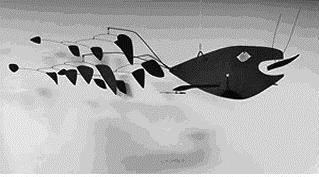
(by permission of the Calder Foundation)
Ready, set, go!
Hold a general discussion with students about mobiles – moving works of art that are created by suspending and balancing shapes. The first mobile was created by an American artist, Alexander Calder, who experimented with combinations of shapes and weights balancing each other. Calder also discovered that the suspended objects move in a rotating fashion due to air currents.
Explain that students will be creating “fish habitat” mobiles that incorporate important elements of their fish’s habitat. Review the components of habitat – food, water, shelter and space (physical components such as rocks, logs, etc.).
Divide the class into groups of 4 or 5, making sure that all students in each group have drawn the same fish.
Review what they’ve already learned about the habitat of their fish from their research in Activity 2. Determine whether additional research is necessary. If so, allow students time to conduct it (individually or in their groups).
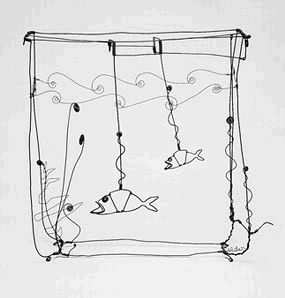
Point out that it might be difficult to visualize specific fish habitat and how all the parts fit together, since few of us spend much time looking around in it. Provide copies of existing art or photography showing habitat for each fish, or post it on-screen if computers are immediately available. Look for common components that indicate major or important habitat features, and how the preferred habitats of the two fish appear to differ.
Tell students that they will now create a physically well-balanced mobile to depict the specific habitat of their chosen fish.
Have each group create a common list of all the habitat components they wish to include in their mobile. Distribute old fishing magazines, scissors, found materials and other drawing or sculpture materials. Have each group use or create images to represent the varied items their fish needs to survive. If necessary, mount items on poster board.
Students should prepare their fish for the mobile by making a small hole near the dorsal fin. Note that they need to place the hole carefully in order to get the balance right. A second hole and a “triangle” of monofilament may be used to correct major imbalances.
Yellow perch should be in schools near shallow bottom rocks and moderate vegetation. Rainbow Trout may be placed close together to represent migrating and spawning groups; further apart if not. Rainbow Trout are different colours and slightly different shapes depending on what life cycle stage and habitat they are in (e.g. breeding fish are more colourful, the lower jaw of breeding males is turned up, non-breeding Great Lakes populations lack a pink to red lateral stripe, and Great Lakes fish are larger and more silvery). Group Rainbow Trout in similar life cycle stages and habitats together, and separate those of different stages and habitats (e.g. don’t group non-breeding adults with spawning adults, or Great Lakes fish with inland fish, since they use different habitats).
Have groups begin with the shorter lengths of wire or wood at the bottom of the mobile and progress to the longer lengths at the top. Balance each section as it is assembled. Each length can contain a single object at both ends, or a single object on one end balanced with a shorter balanced wire containing two objects on the other end.
When mobiles are completed, have students hang them where they can catch air currents.
Explain that the most important aspect of the habitat mobile is that it is well-balanced, just as healthy ecosystems must be well-balanced. Ask students to describe what they think will happen if one element of the mobile is removed. Ask them to describe how balance or imbalance of their habitat mobile relates to the health of ecosystems.
Students should now be able to complete their contest essays.
Other ideas
Make a class display of your habitat mobiles for the school. Have your students explain their mobiles to younger classes.
Please send digital images of your best mobiles to us at jeff.standaert@ontario.ca. We will create a gallery of examples for future contests.
Activity 4 – Globe-trotting Trout
- Purpose: To discuss the pros and cons of the introduction of rainbow trout to Ontario and around the world.
- Outcomes: Students will be familiar with the native range of rainbow trout and the history of introduction and be able to identify advantages and disadvantages of stocking rainbow trout outside of its native range.
- Subject:
- science
- biology
- Group size: 5 - 30
- Site: Indoor
- Time: 45 – 60 minutes
- Supplies:
- chalk board or flip chart and marker
- Resource Sheets (This Activity: Resource Sheet 1; Activity 2: Resource Sheet 1)
- computers with internet access for role-playing research is optional
- North American map is optional
- Before the activity: Copy resource sheets. Prior research by the students is optional. Arrange the classroom or find a spot suitable for a circle discussion.
References:
- This Activity: Resource Sheet 1
- Activity 2 (Know Your Fish): Resource Sheets 1
- Role-Play Research:
- Nonnative Trout: Where We Went Wrong (Midcurrent)
- Nonnative fish a benefit not a burden (The fish site)
- Introduced Species (Amphibia web)
- Rainbow trout (Invasive species initiative)
- Rainbow Trout in Europe Introduction Naturalization and Impacts
- Effect of Stocking Up Freshwater Food Webs (Oat Hill Lake, PDF
- A history of Ontario steelhead (Ontario Out of Doors)
- Trout (New York State Department of Environmental Conservation)
A quick look
Is the rainbow trout’s epic journey around the world a good thing or a bad thing? Students will role-play different points of view to debate the issues surrounding the introduction of rainbow trout outside its native range. In the end they will make their own decision on the globe-trotting trout.
Ready, set, go!
Ask students whether they have seen, heard of, and/or fished for rainbow trout. If so, ask them where they saw or fished for them and in what types of habitats. Ask them if they know how they got there and when. If the student has seen or fished for rainbow trout outside of its native range explain that they were stocked there by humans. Locate the native range on a class map. If no one is familiar with Rainbow Trout refer them to Activity 2: Resource Sheet 1 to see what they look like and to find out what habitats they live in.
Solicit reasons why European settlers might have introduced rainbow trout to Ontario and across the world. As a class, briefly list on a chalk board or flip chart some negative and positive aspects of the spread of rainbow trout.
Tell the class that each of them will be assigned a role to play, and will discuss the question of whether globe-trotting trout is a bad or good thing from various points of view. Assign each student a role (see list below). Tell them to read Resource Sheet 1, and then think about, research and write a short paragraph about the issue from their assigned point-of-view. After the students have written their paragraphs, form a discussion circle and have each student share their assigned role and thoughts and/or position on the issue. As new negative and positive aspects of the introduction of rainbow trout arise add them to the class list.
Role-playing positions
- Angler
- Biologist (charged with protecting native biodiversity)
- Canoeist
- Environmental non-governmental organization representative
- First Nations representative
- Fishery Manager (charged with maintaining a rainbow trout population)
- Fishing equipment store owner
- Fishing lodge owner
- Fishing outfitterVoice of a future generation (choose which generation)
- Home/property owner on a popular fishing river
- Mayor of a town that receives fishing tourists
- Minister of Natural Resources and Forestry
- Non-angler, river lover
- Nature observer
- Small business representative
- Voice of a past generation (choose which generation)
Next tell the students that they are no longer in their specific roles, but are members of the general public who have been asked to anonymously vote on whether the introduction of rainbow trout to Ontario was a good or bad thing. Tally the votes and discuss the winning decision.
For discussion
If the class voted against the introduction, discuss ways to mitigate the current situation (e.g. stop any currently stocking initiatives, allowing capture of rainbow trout but release of native species, reintroduction and stocking of native species etc.). If the class voted that the introduction was a good thing, discuss if they think rainbow trout should still be stocked and introduced to new water bodies.
Discuss if their decision was based on what is good for the environment or what is good for humans. Discuss whether or not environmental questions should become questions of what is best for humans.
Other ideas
Rainbow trout are Ontario’s most common aquaculture species. In 2018, Ontario produced (PDF) 5,416 tonnes (12.8 million pounds) of rainbow trout worth $29 million, 94% of all aquacultural production. Discuss the difference between farming non-native fish in wild waters and stocking non-native fish to wild waters. Discuss issues surrounding aquaculture and the pros and cons. A recent Cottage Life article provides a look into some of the effects of open pen farming, while SeaChoice assesses both open pen and flow through methods related to rainbow trout.
Atlantic salmon, native to Lake Ontario, were extirpated (eliminated from that part of their range) by the late 1800s, due to commercial over-harvest, by-catch (unintentional harvest with other species), and habitat fragmentation and loss. Furthermore, their traditional prey, lake herring, were being replaced by non-native alewife and rainbow smelt. In 1878 rainbow trout were introduced to Lake Ontario. Currently, conservation partners are trying to re-establish Atlantic salmon to their native Lake Ontario and tributary habitat. Due to ecological similarities, rainbow trout compete with Atlantic salmon for food and habitat. Challenge the students to research ways to remove the rainbow trout without harming the rest of the ecosystem (e.g. allowing fishing for rainbow trout but mandatory release of Atlantic salmon, netting and removing rainbow trout during migration or spawning, etc.). For more information on the Lake Ontario Atlantic Salmon Restoration Program and the Classroom Hatchery Program visit Bring back the Salmon
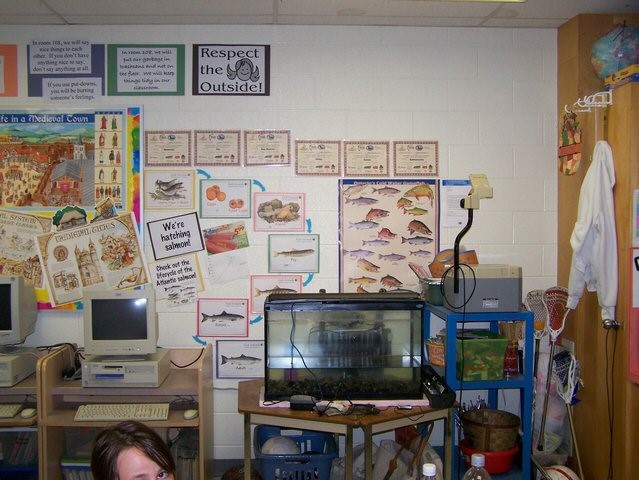
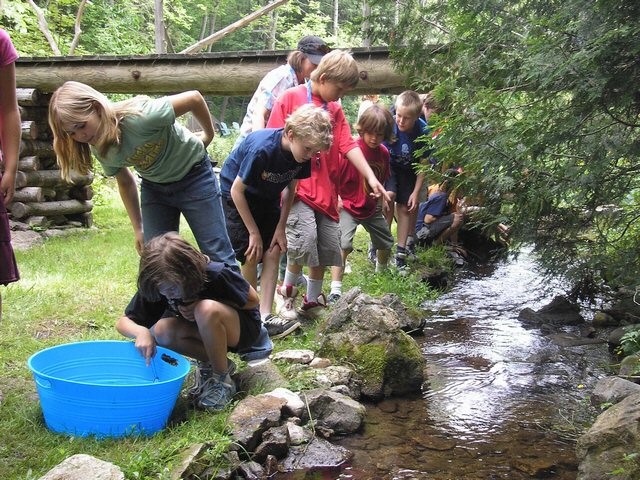
Images source: Bring back the Salmon.
Resource Sheet 1: looking back on the introduction
In North America, rainbow trout are native to the Pacific Ocean, rivers and lakes west of the Rocky Mountains from northern Mexico to Alaska, and probably the Peace and Athabasca River drainages east of the Rockies (Scott and Crossman 1973). In Eurasia, they are native to the Kamchatkan Peninsula, RU, as far east as the Commander Islands, RU to as far south as the mouth of the Amur River of mainland Asia (note: the native range is signified by dotted areas on map below). Due their value as a sport fish, rainbow trout have been introduced widely, to every continent except Antarctica (MacCrimmon and Gots, 1972). In many of these places, rainbow trout are considered “naturalized”, meaning that were introduced, but became self-sustaining populations. Elsewhere, including parts of Ontario, rainbow trout are still stocked to bolster the previously introduced populations for the sport fishery
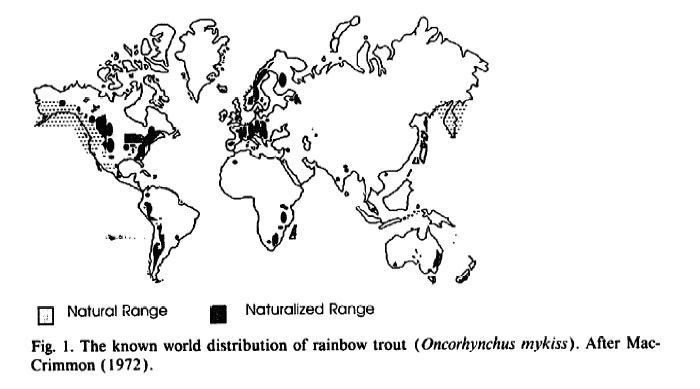
The first recorded shipment of rainbow trout outside their native range occurred in 1874 from California to New York. Many introductions to North American and international locations followed. Rainbow trout were introduced to Lake Huron in 1876, Lake Ontario in 1878, Lake Michigan in 1880, Lake Erie in 1882, and Lake Superior in 1883 (MacCrimmon and Gots 1972).
Rainbow trout proved to be a highly adaptable species and in many cases flourished; though not all introduction attempts were successful. Generations of anglers were grateful for these introductions as they offered a hard fighting and good-tasting game fish. Currently, sport fisheries not only provide local food, but also large amounts of revenue from licenses, equipment, travel, food, and accommodation and guiding services such as fishing lodges, resorts, campsites, and outfitters. In 2005 the economic value of the rainbow trout sport fishery in Ontario was roughly estimated at $23,560,000.
Currently, rainbow trout are being stocked in all of the Great Lakes. Several fishing clubs run private, provincially sanctioned hatcheries. In addition, the NDMNRF stocks in Lakes Ontario and Erie. American agencies also stock rainbow trout into the Great Lakes. According to the Great Lakes Fishery Commission, stocking of non-native predator species such as rainbow trout is intended to complement or enhance natural production of desirable species to meet public demands, provide put-grow-and-take fisheries in areas lacking reproductive habitat, and to suppress other non-native fish that become pests when overly abundant (GLFC 1997 & 2008)
There is a down side however; ecosystem changes accompanied the introduced rainbow trout. In many places introduced rainbows negatively affected and continue to affect native fish, amphibians, and invertebrates.
In the US, rainbow trout have hybridized with native salmonid species such as the Alvord cutthroat, Lahontan cutthroat trout, redband trout, Arizona trout, gila trout, golden trout, and Yellowstone cutthroat trout, which negatively affects genetic integrity and species viability (McAffee 1966a&b; Moyle 1976; Behnke 1992; Propst et al. 1992; Henderson et al. 2000; Kruse et al. 2000). Hatchery-reared fish stocked into the wild are believed to have spread the protozoan that causes whirling disease in some places (Herman 1970; Markiw 1992; Fuller 2009). Furthermore, in parts of the US there is evidence that rainbow trout are competing for food and habitat with native fish such as the goldentrout and Lahontan cutthroat trout (Gerstung 1988; Pister 1991), and preying on and excluding non-game fish, such as suckers, squawfish and the endangered humpback chub from preferred habitat (Moyle 1976; Marsh and Douglas 1997). In Lake Ontario, rainbow trout may be competing with native Atlantic salmon, which conservation partners are trying to re-establish. The introduction of rainbow tout has also contributed to the endangerment of frog species such the mountain yellow-legged frog in the Sierra Nevada (Vredenburg 2004; Knapp et al. 2007), and the Chiricahua leopard frog in southeastern Arizona (Rosen et al. 1995).
Now there are many river and nature lovers, anglers and non-anglers alike, that are hoping to restore the natural ecosystem components. Some argue that rainbow trout should never have been introduced to the wild where they didn’t naturally occur at the expense of native biodiversity.
Once introduced and naturalized to a water body it can be difficult to remove them. Removal methods have included individual fish removal, and laws that have anglers keep rainbows but release native species. Specialized methods have also been tried such as the applications of antimycin A to areas where rainbow trout have been concentrated in Great Smoky Mountains National Park in attempt protect native brook trout. Antimycin A is a fish poison that degrades into more benign compounds; however, there are worries that it will also negatively affect other, unintended species such as aquatic invertebrates (Dinger and Marks 2007).
References
- Behnke, R.J. 1992. Native trout of western North America. American Fisheries Society Monograph 6. American Fisheries Society, Bethesda, MD. 275 pp. Dinger, E.C., and J.C. Marks. 2007. Effects of high levels of antimycin A on aquatic invertebrates in a warm water Arizona stream. North American Journal of Fisheries Management 27: 1243-1256.
- Fuller, P. 2009. Oncorhynchus mykiss. USGS Nonindigenous Aquatic Species Database, Gainesville, FL. http://nas.er.usgs.gov/queries/FactSheet.asp?speciesID=910 [inactive link]. Revision Date: 4/20/2006. Accessed 2 July 2009.
- Gerstung, E.R. 1988. Status, life history, and management of Lahontan Cutthroat Trout. American Fisheries Society Symposium 4:93-106.
- Great Lakes Fishery Commission (GLFC). 1997. A joint strategic plan for management of Great Lakes fisheries. Ann Arbor, Michigan. 42 p.
- GLFC. 2008. Strategic vision of the Great Lakes Fishery Commission for the First Decade of the New Millennium. Ann Arbor, Michigan. 40 p.
- Henderson, R., Kershner, J.L., and C. A. Toline. 2000. Timing and location of spawning by nonnative wild Rainbow Trout and native Cutthroat Trout in the South Fork Snake River, Idaho, with implications for hybridization. North American Journal of Fisheries Management 20:584-596.
- Herman, R.L.,1970. Prevention and control of fish diseases in hatcheries. Pages 3-15 in S.F. Snieszko, editor. A symposium on diseases of fishes and shellfishes. American Fisheries Society Special Publication 5, Bethesda, MD.
- Hulbert, J.P. 1996. Whirling disease: a resource stewardship challenge. Fisheries Magazine 21:26-27.
- Knapp, R.A., Boiano, D.M., and V.T. Vredenburg. 2007. Removal of nonnative fish results in population expansion of a declining amphibian (Mountain Yellow-legged Frog, Rana muscosa). Biological Conservation 135:11-20.
- Kruse, C.G., Hubert, W.A., and F.J. Rahel. 2000. Status of Yellowstone Cutthroat Trout in Wyoming waters. North American Journal of Fisheries Management 20:693-705.
- Marsh, P.C., and M.E. Douglas. 1997. Predation by introduced fishes on endangered Humpback Chub and other native species in the Little Colorado River, Arizona. Transactions of the American Fisheries Society 126:343-346.
- McAffee, W. R. 1966a. Golden Trout. Pages 216-221 in A. Calhoun, editor. Inland Fisheries Management. California Department of Fish and Game.
- McAffee, W. R. 1966b. Lahontan Cutthroat Trout. Pages 225-231 in A. Calhoun, editor. Inland Fisheries Management. California Department of Fish and Game.
- MacCrimmon, H. R. 1971. World distribution of Rainbow Trout (Salmo gairdneri). Journal of Fisheries Research Board of Canada 26:1699–1725.
- MacCrimmon, H.R. and B.L. Gots. 1972. Rainbow trout in the Great Lakes. Ontario Ministry of Natural Resources. Toronto, Ontario. 66 pp.
- Markiw, M.E., 1992. Salmonid whirling disease. US Fish and Wildlife Service, Fish and Wildlife Leaflet 17, Washington, DC.
- Moyle, P. B. 1976. Fish introduction in California: history and impact on native fishes. Biological Conservation 9:101-118.
- Pister, P. 1991. Golden Trout Oncorhynchus aquabonita. Pages 280 -285 in J. Stolz and J. Schnell, editors. Trout (The Wildlife Series). Stackpole Books, Harrisburg, Pennsylvania.
- Propst, D.L., Stefferud, J.A., and P. R. Turner. 1992. Conservation and status of Gila trout, Oncorhynchus gilae. The Southwestern Naturalist 37: 117-125.
- Rosen, P. C., Schwalbe, C.R., Parizek, D.A. Jr., Holm, P.A., and C. H. Lowe. 1995. Introduced aquatic vertebrates in the Chiricahua region: effects on declining native ranid frogs. Pages 251-261 in Biodiversity and Management of the Madrean Archipelago: the sky island of the southwestern United States and northwestern Mexico. USDA Forest Service General Technical Report RM-GTR-264.
- Scott, W.B. and E.J. Crossman. 1973. Freshwater Fishes of Canada. Bulletin 184. Fisheries Research Board of Canada. Ottawa. 966 p.
- Vredenburg, V. T. 2004. Reversing introduced species effects: Experimental removal of introduced fish leads to rapid recovery of a declining frog. Proceedings of the National Academy of Sciences, USA 101:7646-7650.
Activity 5 - Perch predicament

- Purpose: To learn about the basic habitat needs of all animals, and in particular yellow perch, and how habitats can support just so many fish.
- Outcomes: Students will know the importance of food, water and shelter to yellow perch, as well as some types of food and shelter that perch require and are adapted to.
- Subject:
- science
- biology
- Group size: Class (work as individuals or small groups)
- Site: Outdoors and Indoors
- Time: 60 – 90 minutes
- Supplies:
- Resource sheets
- blackboard or flip chart
- card stock (optional)
- glue (optional)
- other habitat need option represented by coloured markers (e.g. poker chips)
- string or surveyor’s tape to mark area boundaries
- Before the activity: Copy resource sheet 1 if used and glue individual needs to card stock. 5 sets of needs to every 10 students is a good ratio. Spread habitat markers throughout marked activity area, and mark area boundaries. A 20 x 20 m area with trees and shrubs is enough for about 30 students.
References:
- Activity 2:
- More detail on yellow perch/brook trout interactions:
- The effect of yellow perch on the trophic ecology of brook trout: the role of intraguild predation
- The Effect of Competition with Yellow Perch on the Survival and Growth of Planted Brook Trout, Splake, and Rainbow Trout in a Small Ontario Lake
- Overpopulation and growth of yellow perch (Perca flavescens) and the potential effect of increased competition on brook trout (Salvelinus fontinalis) in Long Lake, Halifax County, Nova Scotia (PDF)
- A Biological Synopsis of Yellow Perch (Perca flavescens, PDF)
A quick look
In this activity students will actively interact outside as yellow perch trying to meet their needs, then look at the potential impacts as yellow perch invade brook trout territory through a hands-on simulation.
Ready, set, go!
Ask the students what they need to survive. Write down all answers randomly on the board. If necessary have a quick discussion of needs versus wants, and eliminate any wants. Once you have a fairly large number of needs, try to combine different specific needs into a few large categories by similarity. See if you can come to ground on food, liquids (all are water-based) and shelter/space.
Indicate that they are going outside to search for needs as one of the fish from the Kid’s Fish Art Contest, yellow perch.
At the edge of the activity area, explain that they are young perch who must find a new area to live in. Show them the designated habitat area and review the sorts of things they need to find there: food, water and shelter/space. Explain that examples are on the hidden cards, or represented by different coloured markers. The object is to find one card or marker from each category. Stress that they should not keep a second card/marker from any category, but should put it back where they found it. Stress also that perch do not destroy their habitat, and that they should exercise the same care not to trample plants, etc. They should also know your call-in signal.
Allow a reasonable amount of time for the students to search for the cards, and call them in again when you see that the card finding is slowing down. It is not essential that all cards be found.
First ask if anyone did not find any cards. If so, ask what would normally happen to a perch who found none of those three things (migrate or die), and then explain that, in this case, students are magically transformed into a “perch judge”. If some students found all three, they are secure in the area and will also act as a judge. The remaining students will have only one or two cards. Try to pair these students so that the cards they hold make one full set of the three habitat requirements. Determine which of the competing perch is best through a simple competition such as thumb wrestling or rock/paper/scissors. Organize contests within the pairs judged by you and the perch judges, the winners taking their place in the territory with those who found all three card types.
Indicate that a natural area can hold just so many living things, and that the winning students represent the number of healthy yellow perch that this area can support. Emphasize that this number has little to do with the overall size of the natural area, or habitat. Another term for this is carrying capacity.
For discussion
Would yellow perch necessarily be competing directly with each other, as in this activity? If too many perch were in an area, and none was clearly dominant, what might happen? [often fish populations like this will be stunted due to limited food; parasites and disease can more easily pass from fish to fish due to more common contact and low resistance] Is this limited to fish? What about people?
Have the students predict what would happen if only one of the three needs were greatly reduced or greatly increased. If the predictions vary, run the activity again based on the new scenarios and see which predictions the results match.
Ask what would happen if a set population of yellow perch were invaded by another fish with similar habitat needs, or if perch invaded the habitat of another fish. This discussion could be used to lead into the Bean Jars activity in Other Ideas.
Other ideas
Review local papers for projects or events that might change fish habitat. Decide which basic requirements will increase or decrease for the most common local fishes, and how populations might be affected.
Become involved in a local Land Stewardship and Habitat Restoration Program that will increase one or more basic requirements in a local lake or stream.
Bean Jars! (Adapted from Youth Fisheries Education Program Newsletter, NDMNRF, 1991)
- Fill 500 ml large-mouth jars (one per group of six students) right to the top with well-mixed, dried beans of different sizes and colours (exclude one type, e.g. limas). Put plates under the jars to catch the overspill. Identify the largest bean in the jar as brook trout. Tell the students that their jar represents a natural, balanced aquatic community with each type of bean representing different native species. Now have them add yellow perch, an introduced species to this lake or river, by adding a number of lima beans to the jar. Push them in with small sticks. Continue adding until a number of brook trout are pushed out of the jar. Discuss what happens, and how, in order to make room for new species, a number of other individuals or species (if all of one type of bean is completely removed) are eliminated through competition for food, predation or other means. Make sure that the perch are well-distributed in each jar.
- Indicate that introduced perch will often outcompete brook trout, a favoured game fish, in smaller lakes and rivers. Often, people living nearby want the perch removed so that the brook trout can flourish again. Challenge the students to remove the yellow perch (lima beans) without “harming” the rest of the contents (i.e. having them spill out). Tell them for every perch they remove they are allowed to add a brook trout back in. Discuss how this can be difficult, in the jars and in nature. Have the students come up with real-life ways to remove the perch without harming the rest of the ecosystem (e.g. allowing fishing for yellow perch but mandatory release of brook trout). Ask which is better, keeping fish out of a lake or stream, or trying to remove them once they’re there. Have students come up with ways to keep popular fish like yellow perch out of areas where they do not occur.
Yellow perch prefer rivers, lakes and ponds with some vegetation growing in it. Have students look at pictures of yellow perch and ask why that might be. Show or project a copy of Resource Sheet 2 and have students slowly back away until one fish ‘disappears’. Does this confirm their reasons?
Resources Sheet 1: Fish needs
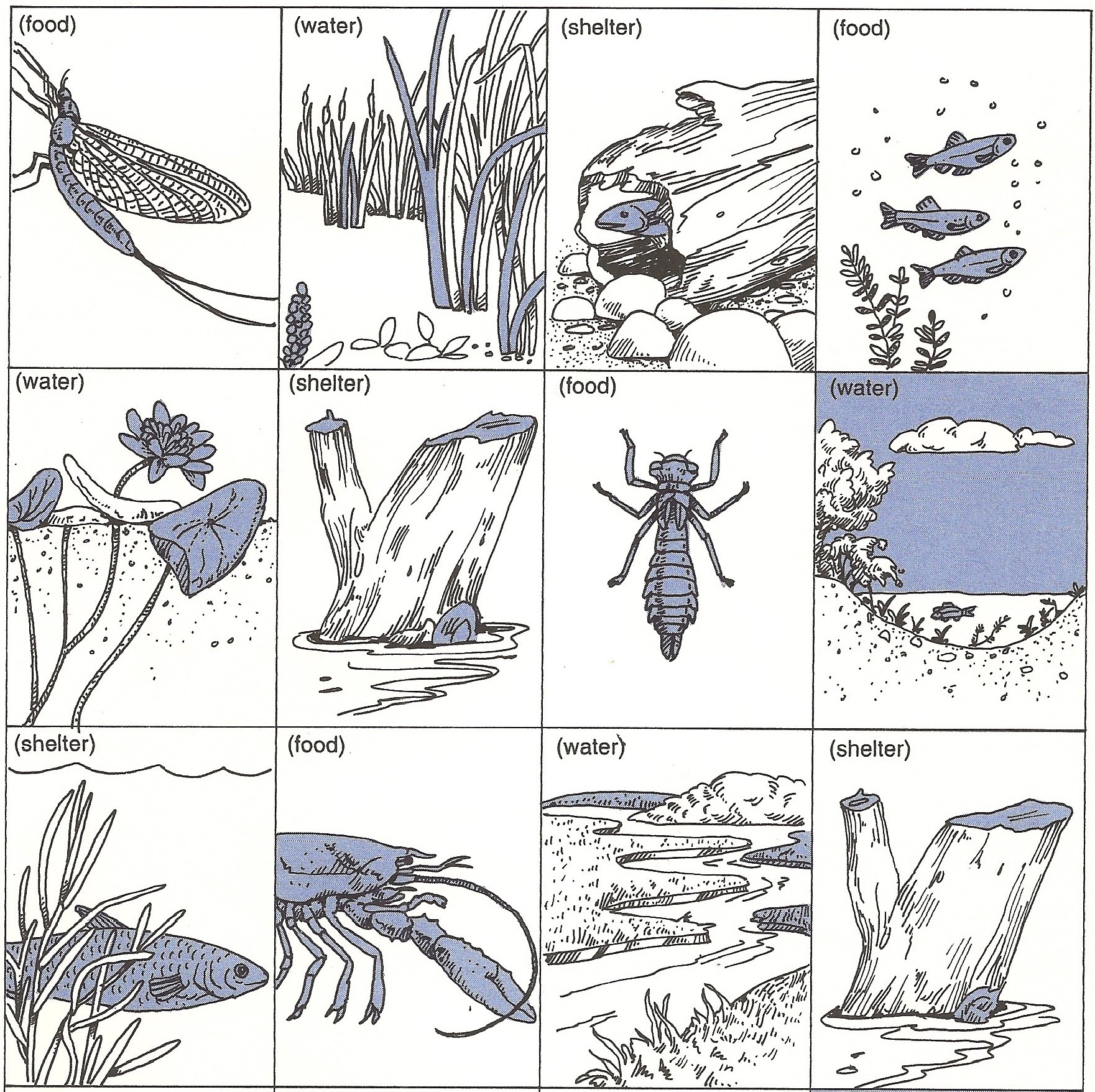
Resource Sheet 2: Disappearing Perch
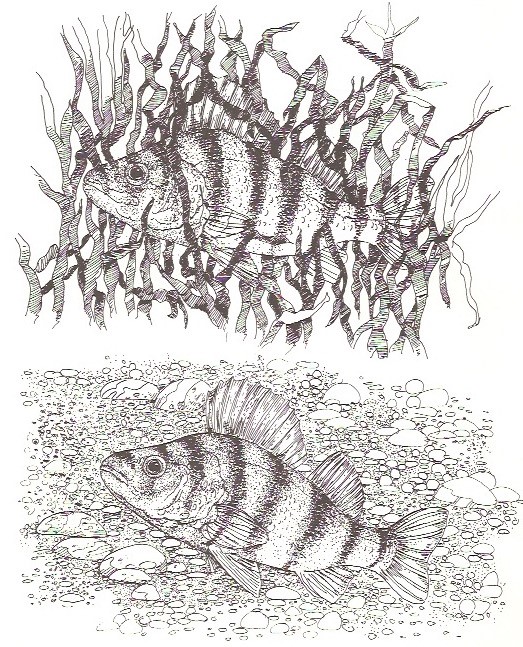
Activity 6 - Sketch Studies
- Purpose: To develop “field” sketching techniques, focusing on the key identification elements of either Rainbow Trout or Yellow Perch.
- Outcomes: Students will create a number of sketches, including key aspects of their fish, e.g.:
- fins
- mouth
- eye area
- natural poses that their fish may take
- habitat components to be included in their final drawing
- Subject:
- visual arts
- science
- biology
- Group size: Class
- Site:
- Classroom
- computer lab
- Time: 45 minutes, plus field exploration time
- Supplies:
- sketching materials
- scrap paper for journals
- Before the activity: assemble journals if students aren’t to do them; do several image searches and list good images for students to see
References:
See References, Activity 3
A quick look:
Students will conduct a “field” exploration, creating and keeping a “field journal” of sketches that will be used later to help them draw key elements of their final image.
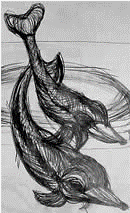
Ready, set, go!
Explain that it is now time to start planning their actual drawing or painting of a rainbow trout or yellow perch. Indicate that wildlife artists often start the way they have, by researching their subject and assembling images. Often, the next step is a field trip to the actual habitat, with field sketches of the habitat and, if they’re lucky, the actual animal. Fish artists will don scuba gear and explore underwater, sketching on waterproof “slates”, taking underwater photos or video and just observing the interactions of their subject and its environment. They will also bring their subjects back with them, keeping them in aquaria for observation and sketching before returning them to the wild.
Suggest that it would be difficult to take a whole class underwater, especially at this time of year. Instead, students will take a virtual field trip, applying sketching techniques to their discoveries as they go along.
Introduce field journal keeping by having students first practice some sketching techniques:
- practice gesture sketching in quick, timed (5-30 second) sketches of stationary objects;
- try quick behavioural sketches of fish in aquaria, birds at feeding stations, etc.
- introduce contour sketching using hand-held objects, looking only at the object and drawing one continuous line for the entire sketch; gradually increase “peeking” to 25% of the time;
- draw generic fish, or fish shapes, beginning with two inter-locking arcs to establish a basic “streamlined” shape; modify into sinuous shapes using flattened, asymmetrical figure-eights to show fish turning or swimming, or change the shape of the arc to produce various fish body types. Add basic body parts to the better shapes (a trout is used in this tutorial). Go on to trout or yellow perch.
Provide or have students create “field journals”, which may be as simple as squares of scrap paper stapled together. At the top of each page they should note the date, time, location, and any details about the type of drawing and the source of their work.
Armed with their field journals, the students are ready to begin their virtual trip. Trip “locations” could include:
- image searches using web tools such as Google, focusing on good photographs of living fish, accurate biological drawings and artwork of fish in natural settings
- image searches in fishing or outdoors magazines (In-Fisherman, Outdoor Canada, Real Fishing, Ontario Out-of Doors) – credible fish art lies within!
- aquaria that contain their own or similar species. Note: fish may be collected and kept for short periods of time using Scientific Collectors’ Permits, available from Ministry of Northern Development, Mines, Natural Resources and Forestry District Offices. Speak directly to the Office about the limitations of the permit and likely fish locations. Keeping fish of this type for any length of time requires some skill and experience; unless fish can be kept at reasonably low temperatures, they will have to be acclimated to cold conditions again before being returned to the wild
- commercial aquaria or zoos
Sketching topics should include:
- elements of the fish that set it apart from others, e.g. fin size and location, mouth shape, size and structure, general body shape (including head-on views) and colour patterns
- important habitat components
- ways to simulate movement or natural fish positions
- interesting points of view from which to create their image
Indicate that their sketchbooks will provide the “notes” that they will use to create their final artwork.
Activity 7 - Kid’s fish artwork
- Purpose: To produce final art for the NDMNRF Kids’ Fish Art Contest
- Outcomes: Students will be able to integrate all art and design principles previously introduced within a single painted or drawn composition, using a variety of technical art production skills, and communicate through their art a knowledge of fish anatomy and habitat.
- Group size: Class
- Site: Classroom
- Time: 100 – 120 minutes
- Supplies:
- pencils
- paints or other drawing supplies
- watercolour paper or illustration board meeting competition requirements
References:
Kids Fish Art Contest (specifications and Kids’ Fish Art Contest winners; scroll down)
Ready, set, go!
Have students assemble all the studies and reference materials that they have done to date. They might wish to view the previous artwork for the Outdoors Card to see how the artists handled both composition and space requirements. These would apply as well to the Young Angler’s Licence.
Ask students to prepare a series of composition studies for their competition painting or drawing that considers the following issues:
- In addition to the central fish, will their be other fish, animals or plants in the picture? What will be their attitudes or position relative to the focal fish?
- Will the vantage point be from above, from below or at eye level?
- What physical habitat components will they include?
Encourage students to study various combinations of these elements and finally select a strong composition, which also provides an opportunity to display the key external features of their fish, using artistic techniques.
Do not allow students, under any circumstances, to reproduce materials that are protected by copyright – this is against contest entry rules, and also discourages creativity.

Finally, ask students to select a medium they feel comfortable with, and execute the painting or drawing of their chosen design. Begin this work with enough time for repetitions if something goes wrong or if the student wants to try several different compositions or techniques.
Assemble the final art, and review each piece for balance, composition and perspective, as well as effectiveness at portraying their fish and its habitat.
If they haven’t already, direct students to review their research from Activity 2, and create the one-page essay that will accompany their drawing. Check for accuracy and completeness
For discussion:
How do the paintings of rainbow trout or yellow perch differ from one another? What are the major differences in habitat for each fish? What are the similarities in how each fish is portrayed? Are there any unique perspectives that strengthen a particular composition, or highlight significant characteristics of a fish or its habitat?
